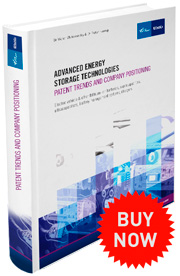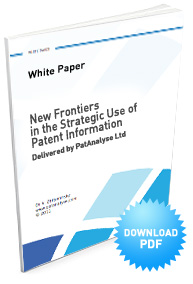Advanced Energy Storage Technologies

"Advanced Energy Storage Technologies: Patent Trends and Company Positioning"
To purchase this report please visit www.IDTechEx.com/patent
This report contains detailed Patent Maps including ones using technology taxonomies. The report is provided with further insight into the conflicting picture between marketing and IP intelligence.
 Download White Paper Download White Paper
"New Frontiers
in the Strategic Use of Patent Information"
 |
 Sample analysis of Patent Maps
Even a quick analysis of several Patent Maps can give a good insight in to the company positioning in the global R&D competition
The novel visualisation technologies developed by PatAnalyse allow the provision of clear, easy to communicate views of patent landscapes, and have successfully been used in a range of tailored patent assignments in the public and private sectors. The PatAnalyse mapping methods present complex information about the patent landscape in the form of a coloured 'Intensity Map' (see illustrations) each of which represents a two dimensional matrix with fixed user-defined dimensions that highlight key features in an intuitive way. Such features can include the strengths and weaknesses of selected players, ‘hotspots’ of activity and trends over time. The two axes of the map can be selected from any sub-set of the original bibliographic data and classification schemes. For example, Assignees can be mapped against Technology clusters (categories) to show comparative Technology ownership. Alternatively, Technologies can be mapped against Year to show technology time line trends. The bar charts along the X and Y axis show the total number of documents against each axis. The main area of the map indicates the number of documents in the cell where the X and Y axes categories intersect. The depth of colour at each cell indicates the number of documents. A separate legend to the graph shows the non-linear colour scale used for converting numbers to colours.
The ten Patent Maps discussed below represent a small extract from the results of the "Advanced Energy Storage technologies: Patent Trends" study. Seven out of the ten Patent Maps represent patent analysis at the top level of the project without going into the level of detail provided by the bespoke technology taxonomy. Nevertheless even such a top down view of the patent portfolio can provide quite useful insights.
Figure 1:
Top 50 Assignees vs Country of invention
- The patent portfolio is dominated by two Japanese players - Panasonic and Toyota, and two Korean players - Samsung SDI and LG Chemical
- Japanese companies heavily dominate the patent landscape, but even Koreans companies are ahead of US; this is a rare exception in patent studies
- The list of the second tier companies is more international. Japanese companies like Sony, Hitachi, Denso, Nissan, Mitsubishi, Toshiba, and Honda are joined by Ford, General Motors, Robert Bosch, and not surprisingly by Chinese BYD
- US activity is dominated by the governmental grant support which is reflected in the strong position of US government and US Universities on the Patent Maps
Figure 2.
Top 50 Assignees and their strategy for applying to National Patent offices
- In spite of the geography of the main players the most popular destination for patenting the inventions follow the markets – foreign patent applications are taken predominately to US, China and Europe. Patent applications in Japan and Korea are heavily dominated by the domestic companies with some added overspill from Korea to Japan and vice versa
- Samsung SDI, and to a lesser degree Panasonic, are ignoring the International Patent office WIPO in their patent filings
Figure 3.
Country of Invention vs National Patent Office Country
- This Patent Map aggregates both large and small players from the same country to provide an overall view of the trends
- Already a major manufacturer of lithium ion batteries, in future China will become an even more important patent destination for foreigners due to the Chinese government financial support for promoting electric vehicles. However, domestic Chinese R&D in energy storage technologies is not yet resulting in major patent activities
- A substantial amount of patents taken to China from Japanese and Korean companies is supported to a lesser extent by US and European companies. However both US and Europe are gradually starting to take part in the trend
Figure 4.
Citation links between Top Assignees
On this Map the citation links from patents are used as a measure of the international visibility of R&D efforts of different companies. In order to correct the otherwise biased citation pattern, the self-citations (citations from one patent to another patent of the same Assignee) are ignored. Some apparent white spots in the busy areas on the Patent Map can be related to such removed self-citations.
- The citation network analysis shows the reduced dominance of the main four players. As a result LG Chemical has even dropped out from the list of the first tier players
- The refreshed list contains names like Sony, Hitachi, Samsung SDI, Panasonic, Toyota, Nissan, and Honda
- Not surprisingly the citation link analysis shows that Toyota is related more to the electric vehicle makers and Panasonic - to battery makers. Nevertheless both companies do overlap in the lithium traction battery development space
- Both Toyota and Panasonic are cited by almost everyone else in their respective groups. So they represent impressively integrated R&D activities
Figure 5.
Most prolific Inventors as a measure of aggressive patent strategies
The major four players have a relatively similar number of patents in the project portfolio. From the analysis of the most prolific inventors from these four companies it is obvious that Panasonic has the most aggressive patent strategies and LG Chemical is least aggressive.
Figure 6.
Comparison of Profiles for top companies in Lithium Traction batteries
Three Patent Maps with a fixed colour scale for Panasonic, Toyota, and LG Chemical are presented for the patents relating to Lithium Traction Batteries. Samsung SDI is not shown along other players as this company is not involved in this specific technology development. It is easy to see that:
- Toyota has shown an aggressive growth by being the new but bold entrant to the area
- Panasonic has demonstrated a steady activity
- LG Chemical is showing a declining level of patent activities and most probably a reduced R&D spend for the development of the new generation of lithium traction batteries
- It seems that LG Chemical is shifting its financial resources from R&D to manufacturing which should pay off in a short term but might become quite a risky strategy in the long run
- Toyota is backing the use of nanotechnology for reducing the charging time of lithium electrodes and improving their lifetime
- Panasonic has no apparent interest in nanotechnology; instead it is focusing more efforts on technologies related to separators and cathode chemistry
Figure 7.
Time line for different countries
- The evident growth rate in patent activities in Advanced Energy Storage is caused partially by European and US players waking up to the challenge
- It is useful to point out that the US companies substantially outnumber Koreans once all small players are taken into account
- Figure 7b presents a Patent Map plotted in the normalised form. It is used to show the deviation of activities of each country from the common trend. The country which follows the trend will look predominantly yellow (this colour represents the value equal to one)
- Koreans are substantially reducing their contribution to global R&D activities with Europeans and China substantially increasing their input.
- The finding regarding reduced R&D efforts of Korean companies is mainly related to the behaviour of LG Chemical but is also related to some degree to the similar trend from Samsung SDI
|

